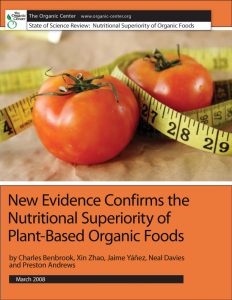- Introduction
- 2013-2015 British Journal of Nutrition Meta-Analyses
- 2013 PLOS ONE Milk Study
- 2012 Annals of Internal Medicine analysis by Smith-Spangler et al.
- 2009 American Journal of Clinical Nutrition study by Dangour et al.
- The 2008 Organic Center Report
See also:
- Introduction to Nutritional Quality
- Organic Vs. Conventional Foods
- Key Nutritional Quality Studies: Food Comparison
Introduction
 This page is a portal for important, large-scale meta-analyses that have taken a comprehensive comparative look at the nutritional quality of organically and conventionally grown foods.
This page is a portal for important, large-scale meta-analyses that have taken a comprehensive comparative look at the nutritional quality of organically and conventionally grown foods.
Meta-analysis is a statistical tool to extract more robust insights from several different studies focused on the same basic question, like “does organic milk offer nutritional advantages for consumers, compared to milk from cows on conventionally managed farms?” Or, do drugs of “X” class prevent cardiovascular disease?
Each study is discussed briefly below, with links to the full text, FAQs, and other related content.
British Journal of Nutrition Meta-Analyses
An international team of scientists was convened in 2013 by Newcastle University in the U.K., and carried out the most sophisticated large scale analysis ever of the differences in organic vs. conventional food. Their work produced three meta-analysis papers published in the British Journal of Nutrition that looked at plant-based foods, milk and dairy, and meat products. The major findings of each study are described below as well as links to press coverage and other content relevant to these important analyses. For details about each study, click on the FAQ document below, and for information on these studies from Newcastle University click here
I: Plant-Based Foods – Click Here for journal article
This study has three main findings. (1) Organic crops have, on average, higher levels of antioxidants than conventional crops, (2) organic crops have lower cadmium levels than conventional crops, and (3) pesticide residues are present much more frequently in conventional crops than organic ones. Particularly compelling is the fact that organic crops have, on average, significantly higher levels of antioxidants than conventional crops. Average total antioxidant activity was a 17% higher in organic versus conventional crops. For some individual antioxidants, the differences were much greater — 69% higher levels of flavanones, 28% higher levels of stilbenes, 50% higher levels of flavonols, and 51% higher levels of anthocyanins.
Related content:
- Frequently Asked Questions
- Presentation of Key Figures (pdf)
- Press Release
- Organic Crops Booklet
- Supplemental Data
Media coverage:
- “Clear differences between organic and non-organic food, study finds,” July 2014, The Guardian
- “Study of Organic Crops Finds Fewer Pesticides and More Antioxidants,” July 2014, The New York Times
- “Organic foods are more nutritious, according to review of 343 studies,” July 2014, Los Angeles Times
- “Are Organic Vegetables More Nutritious After All?,” July 2014, NPR on radio interview
- “Is Organic Food Really Healthier?,” July 2014, Time
- “Parsing of Data Led to Mixed Messages on Organic Food’s Value,” October 2012, The New York Times
II: Milk and Dairy Products – Click Here for journal article
This study found that organic milk and dairy products are healthier because they contain higher levels of health-promoting omega-3 fatty acids, including more very long-chain omega-3s. Overall, organic milk and dairy products also have a far healthier mix of fatty acids. The concentration of health-promoting, total poly-unsaturated fatty acids (PUFAs) in organic milk and dairy products was, on average, 7% higher than in corresponding milk and dairy products from conventionally managed livestock farms. Also, health-promoting omega-3 fatty acids in dairy products were, on average, 46% higher than in conventional milk and dairy products. Importantly, the overall concentration of the critical, very long-chain omega-3 fatty acids was 58% higher in organic versus conventional diary products. In addition, the concentration of the heart-healthy fatty acid CLA (conjugated linoleic acid) was 34% higher in organic milk and dairy products. The ratio of omega-6 to omega-3 fatty acids was also 79% lower in organic milk and dairy products, an important advantage for individuals dealing with or working to avoid heart disease, diabetes, chronic inflammation, and overweight. The typical balance in omega-6 to omega-3 fatty acid intakes in the U.S. is 10:1 to 15:1, a range that is clearly a risk factor for a number of chronic health problems.
Plus, there are nutritional advantages linked to organic milk consumption beyond fat levels and quality. The Newcastle meta-analysis found that organic milk contains, on average, significantly higher levels of α-tocopherol (Vitamin E) and iron (Fe), but lower concentrations of iodine (I) and selenium (Se), compared to conventional milk. The meta-analysis also identified trends towards higher vitamin A, ß-carotene, lutein and zeaxanthin, potassium (K), and lower copper (Cu) levels in organic milk, but further studies are required to confirm these results.
For information about different types of fat to help interpret these results, see Good Fat, Bad Fat and this detailed primer.
Related content:
III: Meat Products – Click Here for journal article
This study documented that organic meat is healthier because it has a markedly more desirable composition of fatty acids. The concentration of health-promoting poly-unsaturated fatty acids (PUFAs) in organic meats was, on average, 23% higher than in corresponding meat products from conventional managed livestock farms. Plus, the levels of health-promoting omega-3 fatty acids were, on average, 47% higher than in conventional meat, and the overall concentration of the critical, long-chain PUFA fatty acids was also markedly higher in organic versus conventional meat. In addition to higher concentrations of health-promoting fatty acids, the team found that the levels of some pro-inflammatory fats were lower in organic meat products. The levels of the saturated fatty acids myristic acid were, on average, 18% lower, while the levels of palmitic acid were 11% lower.
Related content:
2013, The PLOS ONE Milk Study
 On December 9, 2013, Dr. Benbrook and his team published an 18-month, nationwide study (full study and summary available) that confirmed that there are large and consistent differences in the fatty acid profile of organic and conventional milk and dairy products in the U.S. The research was carried out by a team led by scientists at Washington State University and appeared in the prestigious peer-reviewed journal PLOS ONE.
On December 9, 2013, Dr. Benbrook and his team published an 18-month, nationwide study (full study and summary available) that confirmed that there are large and consistent differences in the fatty acid profile of organic and conventional milk and dairy products in the U.S. The research was carried out by a team led by scientists at Washington State University and appeared in the prestigious peer-reviewed journal PLOS ONE.
In typical American diets, people consume around 15 grams of omega-6 (ω-6) fatty acids for each gram of omega-3 (ω-3) fatty acids, resulting in an ω-6/ω-3 ratio of 15 — a level far above the heart-healthy goal of around 2:1, or lower. For more information about fatty acids to help interpret these results, see Good Fat, Bad Fat or this detailed primer.
The PLOS ONE study found that both organic and conventional milk and dairy products help lower this key ratio. The average ω-6/ω-3 ratio found in this study for the Organic Valley brand of organic milk is 2.3, while in conventional milk the average ratio is 5.7, still substantially better than most sources of fat in the American diets. The ω-6/ω-3 ratio in organic milk is much lower than in conventional milk, because pasture and forage-based feeds make up a much greater share of daily “Dry Matter Intake” on organic dairy farms, compared to conventional dairy farms. The team also reports that simple steps by consumers can markedly lower an individual’s overall dietary ω-6/ω-3 intake ratio. Overall, they report that organic whole milk had 62% more total ω-3 fatty acids than conventionally produced milk. Among individual ω-3 fatty acids, organic milk concentrations were 60% higher for ALA (alpha-linolenic acid), 33% higher for EPA (eicosapentaenoic acid), and 18% higher for DPA (docosahexaenoic acid). Organic whole milk had, on average year round, 18% higher levels of CLA (conjugated linoleic acid) than conventional milk, 25% lower total ω-6 fatty acids, and 25% lower concentration of LA, the major ω-6 fatty acid.
Related content:
2012, Smith-Spangler et al.
In September of 2012, a team led my Crystal Smith-Spangler, MD published the study “Are Organic Foods Safer or Healthier Than Conventional Alternatives?” in Annals of Internal Medicine. They concluded that “the published literature lacks strong evidence that organic foods are significantly more nutritious than conventional foods. Consumption of organic foods may reduce exposure to pesticide residues and antibiotic-resistant bacteria.” Dr. Benbrook and other experts have critiqued this study widely, as described in the related content below.
Related content:
- Letters to the Annals of Internal Medicine Editor re the Smth-Spangler et al. paper
- The Organic Center Response to Smith-Spangler et al. by Charles Benbrook
- WSU Blog on Smith-Spangler et al.
Media coverage:
- “Parsing of Data Led to Mixed Messages on Organic Food’s Value,” October 2012, The New York Times
2009, Dangour et al
In 2009 a team of British scientists published a detailed meta-analysis in the American Journal of Clinical Nutrition funded by the U.K. Food Standards Agency. This team concluded that organic food offered no significant nutritional benefits. The results of this study by Dangour et al. are presented – and criticized – in the related content links below.
Related content:
- Letters to the Editor of the AJCN on Dangour et al. and Dangour et al. Responses
- TOC Response to Dangour et al. by Dr. Charles Benbrook
2008, The Organic Center Report
 In March, 2008 The Organic Center (TOC) released a thorough review and meta-analysis of the differences in nutrient concentrations across 236 matched pairs of organic versus conventionally grown foods that concluded that organic foods were nutritionally superior to conventionally grown. These results are compiled from 97 high-quality studies published since 1980. Click here for the full report or see the executive summary in English and Spanish.
In March, 2008 The Organic Center (TOC) released a thorough review and meta-analysis of the differences in nutrient concentrations across 236 matched pairs of organic versus conventionally grown foods that concluded that organic foods were nutritionally superior to conventionally grown. These results are compiled from 97 high-quality studies published since 1980. Click here for the full report or see the executive summary in English and Spanish.
